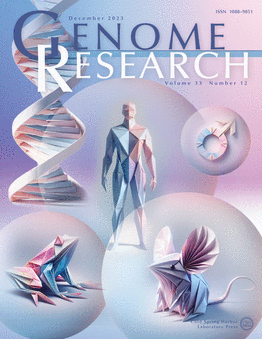揭示甲基化依赖性基因对不同基因组调控元件功能的影响
IF 5.5
2区 生物学
Q1 BIOCHEMISTRY & MOLECULAR BIOLOGY
引用次数: 0
摘要
进化生物学和生物医学的一个主要目标是了解遗传变异、表观基因组和基因表达之间复杂的相互作用。然而,这些因素之间的因果关系仍然知之甚少。mSTARR-seq是一种甲基化敏感的大规模平行报告基因分析,能够同时识别数千个基因组区域的甲基化依赖调控活性,并允许在每个区域的基础上测试DNA甲基化和基因表达之间的因果关系。在这里,我们开发了一种多路mSTARR-seq方案来分析来自欧洲和非洲10个地区的25个个体的自然发生的人类遗传变异。我们鉴定出6957个处于未甲基化或甲基化状态的调控元件,正如预期的那样,这一组富集了增强子和启动子染色质注释。这些调控元件中58%的表达受甲基化调节,甲基化通常与转录减少有关。在我们的调控元件中,我们使用等位基因特异性表达分析确定了8020个对基因调控具有遗传效应的位点;此外,我们发现42.3%的这些遗传效应在甲基化和非甲基化状态之间的方向或大小不同。显示甲基化依赖遗传效应的位点富含GWAS和EWAS注释,暗示它们与人类疾病有关。与分析单个欧洲血统个体DNA的数据集相比,我们的多重分析能够揭示更多的遗传效应和甲基化依赖的遗传效应,强调了在旨在了解基因调控过程的分析中包括不同基因组的重要性。本文章由计算机程序翻译,如有差异,请以英文原文为准。
Uncovering methylation-dependent genetic effects on regulatory element function in diverse genomes
A major goal in evolutionary biology and biomedicine is to understand the complex interactions between genetic variants, the epigenome, and gene expression. However, the causal relationships between these factors remain poorly understood. mSTARR-seq, a methylation-sensitive massively parallel reporter assay, is capable of identifying methylation-dependent regulatory activity at many thousands of genomic regions simultaneously and allows for the testing of causal relationships between DNA methylation and gene expression on a region-by-region basis. Here, we develop a multiplexed mSTARR-seq protocol to assay naturally occurring human genetic variation from 25 individuals from 10 localities in Europe and Africa. We identify 6957 regulatory elements in either the unmethylated or methylated state, and this set was enriched for enhancer and promoter chromatin annotations, as expected. The expression of 58% of these regulatory elements is modulated by methylation, which is generally associated with decreased transcription. Within our set of regulatory elements, we use allele-specific expression analyses to identify 8020 sites with genetic effects on gene regulation; further, we find that 42.3% of these genetic effects vary in direction or magnitude between methylated and unmethylated states. Sites exhibiting methylation-dependent genetic effects are enriched for GWAS and EWAS annotations, implicating them in human disease. Compared with data sets that assay DNA from a single European ancestry individual, our multiplexed assay is able to uncover more genetic effects and methylation-dependent genetic effects, highlighting the importance of including diverse genomes in assays that aim to understand gene regulatory processes.
求助全文
通过发布文献求助,成功后即可免费获取论文全文。
去求助
来源期刊

Genome research
生物-生化与分子生物学
CiteScore
12.40
自引率
1.40%
发文量
140
审稿时长
6 months
期刊介绍:
Launched in 1995, Genome Research is an international, continuously published, peer-reviewed journal that focuses on research that provides novel insights into the genome biology of all organisms, including advances in genomic medicine.
Among the topics considered by the journal are genome structure and function, comparative genomics, molecular evolution, genome-scale quantitative and population genetics, proteomics, epigenomics, and systems biology. The journal also features exciting gene discoveries and reports of cutting-edge computational biology and high-throughput methodologies.
New data in these areas are published as research papers, or methods and resource reports that provide novel information on technologies or tools that will be of interest to a broad readership. Complete data sets are presented electronically on the journal''s web site where appropriate. The journal also provides Reviews, Perspectives, and Insight/Outlook articles, which present commentary on the latest advances published both here and elsewhere, placing such progress in its broader biological context.
 求助内容:
求助内容: 应助结果提醒方式:
应助结果提醒方式:


